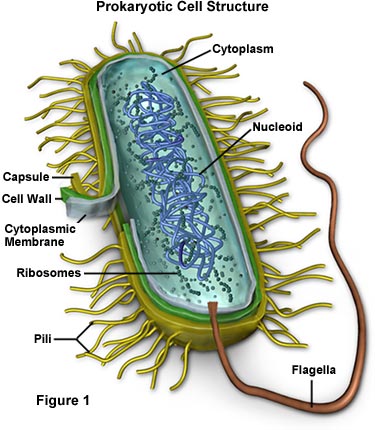So, the video tells you the basic stuff-- how germs can spread, why you should wash your hands before you eat, and never eat anything anyone else has touched, no matter how tempting it might be. But even though they looked like they could harm the woman, there's a chance that it won't make her sick. I mean, it probably will considering the man sneezed them out. But, like I said before, most bacteria are harmless. Some of them even help you.
First of all, bacteria are single celled organisms. They do not have a nucleus, but they do have a nucleoid. Some bacteria break down certain types of food to help us digest it. Some make nutrients that our bodies need. Some can even destroy some types of microorganisms that can make us sick. Less than one percent of bacteria actually harm us.
FUN FACT: Nine out of every ten of the cells in your body are bacterial cells, which means that most of your cells aren't your own.
Okay, now is time for my actual assignment: describe six parts of a typical bacterial cell and give their functions. That other stuff was just stuff you needed to know. Now, please try to enjoy yourselves, okay? Good. Now, a bacterial cell is pretty simple. Here-
- Nucleoid: The DNA in the bacterial cell is usually confined in the nucleoid. It isn't bound by a membrane, but it is still visibly distinct.
- Ribosomes: Ribosomes make protein for the bacterial cell. A good way to remember this is to think of ribs. The word 'ribs' is in the word 'ribosome', is it not. And we all know that ribs give protein, so really, thay fit together.
- Cell Wall: It maintains the shape of a bacterial cell.
- Plasma Membrane: Responsible for the transport of ions, nutrients, and waste across the membrane.
- Capsule: Protects the bacterial cell.
- Flagella: It helps the bacterial cell move. Bacterial cells without flagella cannot move. It almost acts a 'motor'.
- Pilus: Tiny and hairlike, pilus is made of proyein and allow bacteria to attach to other cells.
That's it for today. Hope you enjoyed, and, as always, if you want to know more, where do you go? That's right. To youro-jalen guy's blog and to SuperSara's blog. I'm 98% positive they have awesome information(never be completley positive). Peace, my home dawgs.
ANOTHER FUN FACT: Did you know that there's more bacteria on you than there are people in the world?


ANOTHER FUN FACT: Did you know that there's more bacteria on you than there are people in the world?



This comment has been removed by the author.
ReplyDeleteYour fun facts were good, and it's FLAGELLUM. Not flagella. Just saying. Good job, great grammar, info, spelling, as always. Another great post Teemy.
ReplyDeleteFirst off, SuperSara, the internet gave me flagella, so I guess there is two ways to say it, okay?
ReplyDelete